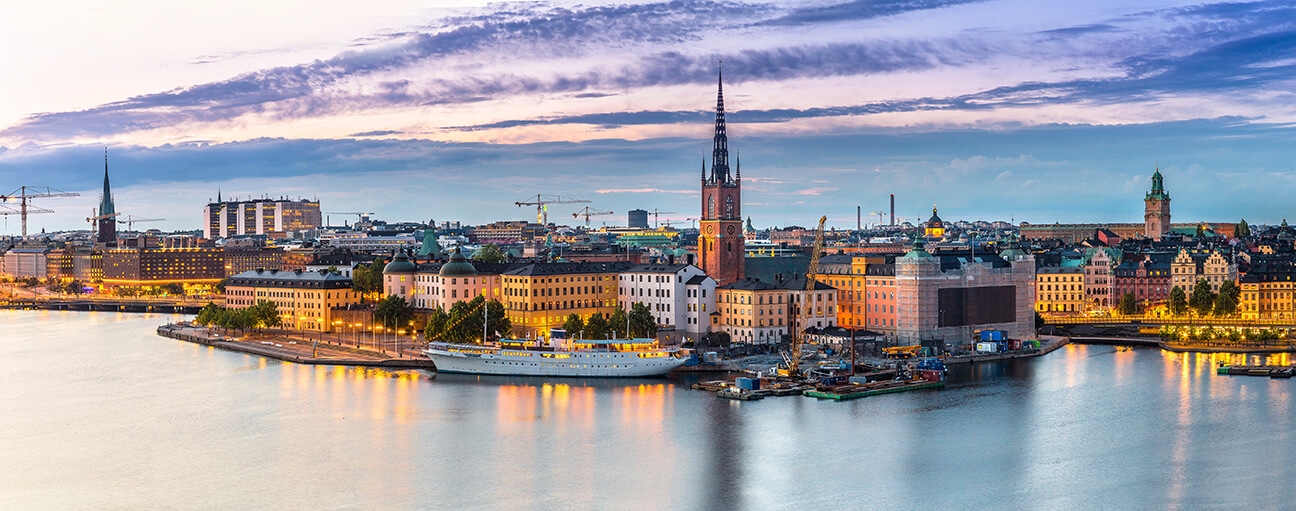Sweden is to Europe like the Amazon is to South America. It is a land full of lakes and forests that hug you the very moment of your arrival. Getting on the bus to leave the airport you are driven through a nature scenario, with snowy trees extending miles.
If you were sweating in the plane because of your ski jacket, it is likely you will freeze outside when the temperature outside is below freezing.
Småland: a land of farms and motorsaws
I started my journey from the airport of Gothenburg in the south, and then headed north to Jönköping, a small town situated on the huge lake Vättern. It is the main city of the central Småland region, literally Small lands, a name completely unfit to describe the majesty of nature here. Everything is huge, at least from a European point of view.
You can walk kilometers in the forests without seeing anyone but some moose, which are still common despite climate change and hunting. If you are lucky you will encounter several frozen lakes where if you come from a warm place like Italy, you can have fun throwing branches and seeing them not fall into the water.
An interesting route to see all of that is on the road that links Jönköping to Gränna, the city of candies. All through there, hundreds of smaller roads may lead you to a little farm in the middle of the several rocky hills where you can start your forest excursion. It is advised to buy some local cheese or meat.
For camping, Swedes are not worried about guests occupying their land, as it is possible, according to local law, to stay in any place for a maximum of two days. Just be wary if you hear a motorsaw: Sweden has a huge problem of deforestation and close to farms the possibility of meeting someone cutting a tree over you increases! Moreover most of the motorsaws around Europe are produced here, in Huskvarna, a nice souvenir to bring back home.
Katrineholm: a delightful anonymous town
Sweden is a very large land with a very low population. Therefore most Swedes live in a few big cities and the rest in little towns pretty much similar to each other.
Katrineholm is a little city a three hours drive north-east from Jönköping. Nature around there is less amazing, not so many rocks, not so many hills. The town has little to offer, but it is still a powerful representation of the Swedish norm. There’s a state-driven alcohol store that closes at 7 pm and a few ethnic restaurants. It is striking to find major companies even there, but this just displays the wealth of Sweden.
If you get bored of the town—there is just a minor Church for the culture nerd like me—you can dive into the surrounding nature and enjoy some delightful decadency. Lots of people left this area as there are several abandoned farms where you can still see bikes left, toys of babies and clothes drying since God knows when.
But still, every bad feeling will go away when at 18, close to a thrift shop, as tradition dictates, you will taste your fika, namely coffee and cake, which is a popular social occasion in Sweden, promoted by previous governments to offer an alternative to heavy drinking, which had been a social problem.
Stockholm: a modern town
If nature doesn’t attract you and you don’t have an intellectual taste for decadency, you just might have to go to Stockholm.
The town spreads through different islands and you can move from one to another by ferry or metro. I strongly advise the first option, that allows you to see a really astonishing skyline. Ancient buildings, like in the Middle Age island-neighborhood Gamla Stan or the early 20th century Town Hall, overlap with modern skyscrapers with animated ads all over them. Stockholm displays all the advantages of being a Swede: modernity, democracy and transparency, based in a glorious past.
Here the Nobel Prizes are awarded in the Town Hall. Nearby, in front of the Parliament, Greta Thunberg held her first strike that revolutionized environmentalism.
Stockholm is a dynamic and prolific place for politics, science and art, as the Moderna Museet shows with its collection of the world’s finest contemporary artists.
It is so modern that some relics of the past seem completely out of context. Like the changing of the guard of the Royal Palace, happening every Sunday morning and performed by young male and female soldiers, well-dressed but without the coordination you can see in Britain or Greece. Sweden has not indeed a long military tradition, even though it recently joined NATO and reimposed a semi-mandatory military service.
Even though Stockholm is modern, you can still feel something that you felt in the two previous locations: homogeneity. If you talk to an elderly Swede he will tell you that Swedes are critical towards whomever breaks social rules. Indeed, astonishingly, there is no massive underground scene in Stockholm, as in other northern European cities like Berlin or Copenhagen, pretty much known for their alternative cultures. Here, men wear cool shirts and women have perfect make-up, so perfect and so cool that you may end up rethinking your own coolness.
Sweden is a fascinating country with a spirit which is difficult to grasp. While visiting it seems that what you see is just the surface of a more extensive iceberg. It is clear in the monotony of the colors and the marble modernity that encompasses every town. It is no surprise that here there is the strongest European tradition of noir literature. It seems like they are covering something, maybe trying to hide the true richness of a country which is definitely worth a visit.










